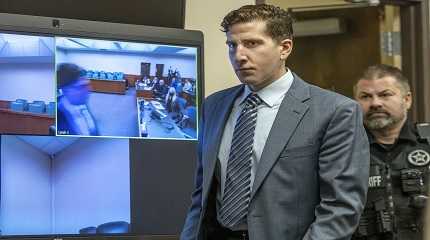
BOISE, Idaho (AP) — Attorneys for a man accused of stabbing four University of Idaho students to death late last year want cameras banned from the courtroom, contending that news coverage of the criminal proceedings has violated a judge’s orders and threatens his right to a fair trial.
Bryan Kohberger is charged with four counts of murder in connection with the deaths at a rental house near the university campus in Moscow, Idaho, last November. A judge entered a not-guilty plea on Kohberger’s behalf earlier this year. Latah County Prosecutor Bill Thompson has said he intends to seek the death penalty, and the case is scheduled for trial this fall, although it could be postponed.
Kohberger was a graduate student studying criminology at Washington State University, which is a short drive from the scene of the killings across the state border. He was arrested at his parents’ home in Pennsylvania, and the unusual details of the case have drawn widespread interest.
Second District Judge John Judge is expected to hear arguments over camera access on Wednesday afternoon.
In a court document filed late last month, defense attorneys Anne Taylor and Jay Logsdon said the media pool photographers and videographers violated the judge’s orders to show a wide shot of the courtroom and avoid recording images of notes on the attorneys’ tables.
Kohberger’s attorneys pointed to photos showing their client walking into the courtroom and watching the court proceedings while seated at the defense tables, as well as more zoomed-out videos that included indecipherable white papers on the defense table and part of Taylor’s laptop screen. At the time, the laptop screen was displaying images from the in-court camera system, which were also being displayed on the large courtroom projector screen throughout parts of the proceeding.
“The cameras’ continued exclusive focus on Mr. Kohberger provides fodder for observers and purported ‘analysts’ on social media, who are not bound by notions of journalistic integrity and who have potentially an even greater reach than traditional media outlets,” the defense attorneys wrote, pointing out unflattering posts about Kohberger on X, formerly known as Twitter.
But Wendy Olson, an attorney representing a coalition of news organizations including The Associated Press, said pool photographers and videographers have scrupulously followed the judge’s instructions, providing a variety of photos and videos of all of the courtroom participants and often keeping the shots as wide as is feasible inside the relatively small courtroom.
In a court document filed last week, Olson noted that news organizations also ran images including close-ups of the judge and experts who have testified in the case. Courtroom cameras provide the public with government transparency and increase understanding about the responsibilities of the judicial branch, she wrote, and can counter false or misleading narratives that frequently spread on social media sites.
“Removing cameras from the courtroom will not impede or diminish media coverage of Mr. Kohberger’s case, but it will lead to a significantly less accurate portrayal of the justice process,” Olson wrote.
Latah County prosecuting attorney Bill Thompson agreed that responsible news media has “enormous value” in helping the public understand the true facts of what occurs in court, but said that can be accomplished without any photos or videos. He wrote in a court document that cameras could have a chilling effect on vulnerable witnesses who were deeply impacted by the deaths and who have already been subjected to threats and harassment online.
Thompson asked the judge to prohibit cameras in the courtroom at least during the trial and any other proceedings where vulnerable victims might be asked to testify.
The bodies of Madison Mogen, Kaylee Goncalves, Xana Kernodle and Ethan Chapin were found Nov. 13, 2022, at a home across the street from the University of Idaho campus. Investigators pieced together DNA evidence, cellphone data and surveillance video that they say links Kohberger to the slayings.




